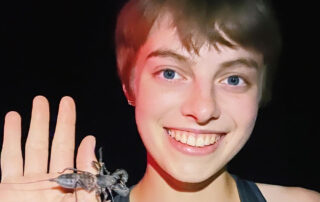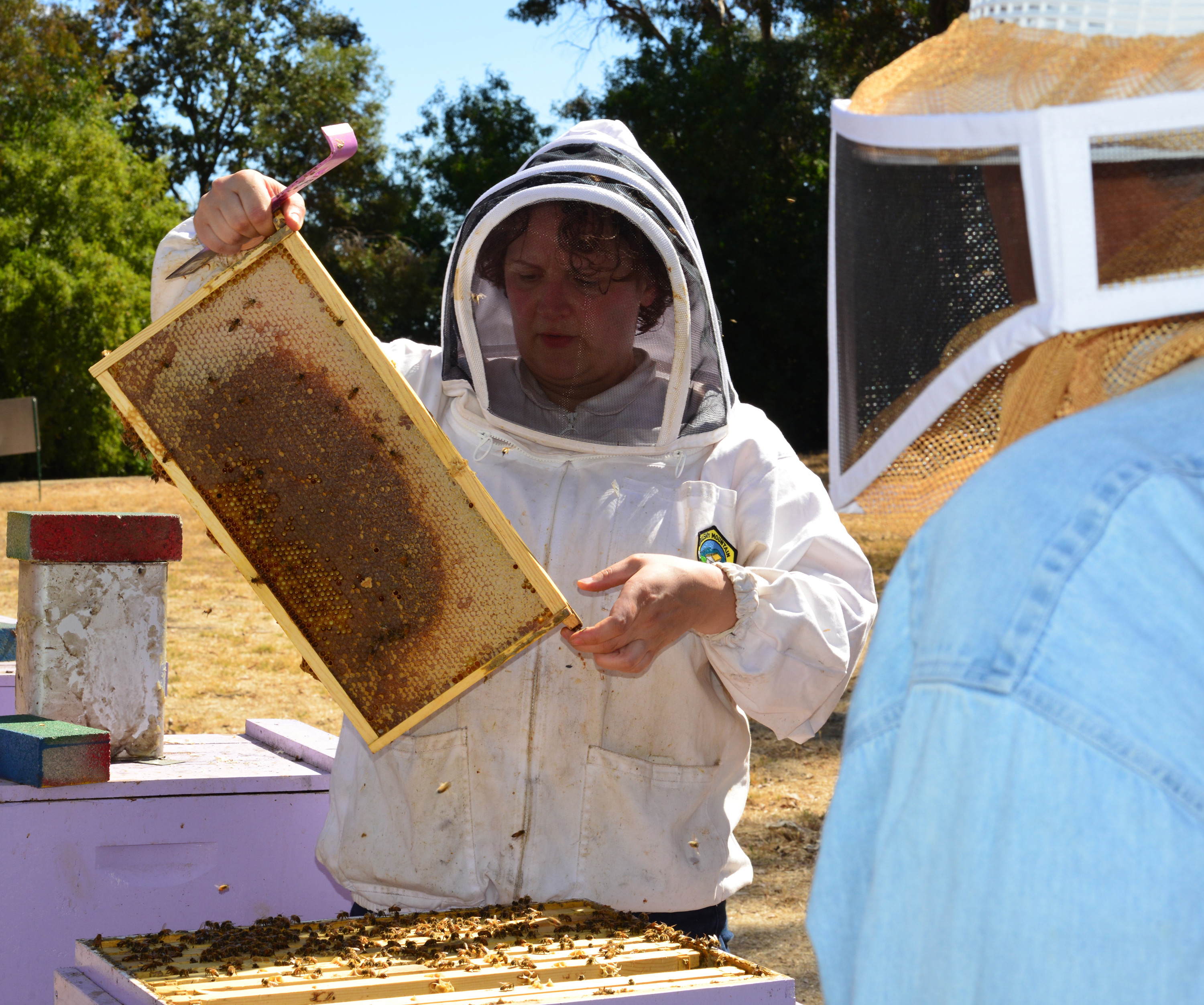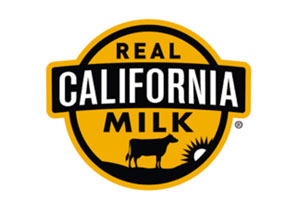University of California, Davis
UC Davis Entomology Major Known Internationally as ‘Gwentomologist’
UC Davis entomology major Gwen Edosh with a whip scorpion she collected in Tucson. The 21-year-old undergraduate researcher has 21,999 followers on her Instagram account.
If you follow “Gwentomologist” on Instagram, you’ll see fascinating images, videos and data on scores of insects, including bees, butterflies and beetles, and such curious critters as wasp-mimicking beetles (genus Clytus) and “burying beetles” or Nicrophorus beetles (genus Nicrophorus).
And you’ll see arthropods such as jumping spiders (family Salticidae) and scorpions (superfamily Scorpionoidea).
Who is Gwentomologist?
She’s 21-year-old Gwendolyn “Gwen” Erdosh, a UC Davis entomology major and undergraduate researcher with 21,900 followers on Instagram, where she shares her fascination, passion and growing scientific knowledge of entomology with the intensity of a moth heading for light.
Erdosh, president of the UC Davis Entomology Club, a scholar in the campuswide Research Scholars Program in Insect Biology (RSPIB), the recipient of a Provost’s Undergraduate Fellowship (PUF) research award, and a volunteer at the Bohart Museum of Entomology, brims with enthusiasm.
In a recent post, she related how she “raised this gorgeous female Hemileuca eglanterina (sheep moth) from a tiny caterpillar!! First time successfully rearing these species. I got a male and female, and I was hoping they’d mate but it never happened. Guess they didn’t like each other. I have some eggs overwintering, and I hope they make it ‘til the spring!”
“I’m in awe with this species of silkmoth,” Gwen continued. “They are one of the few northern California native silkmoths (Saturniidae) and feed on Ceanothus and choke cherry leaves. The adults are day-flying and can fly incredible fast in a zig-zag motion, making catching them extremely hard. The males can be seen flying high in the Sierra mountains in July. Females are much harder to spot, as they are slower and hide out in the foliage, emitting pheromones to attract the males towards them.
“The best way to see the adult is to rear caterpillars,” Gwen noted. “In the past, I attempted to rear the caterpillars and ran out of host plant. With no method of transportation to the high sierras, I had to give them rose leaves, which worked…until it didn’t. They all got a disease and died. This time, I had tons of host plant, and was able to return to the mountains in my car to get more (they eat way more than you’d expect). I’m really happy that I was able to raise this species successfully, and hope to do it again next spring! The insect season is coming to a close, but certain species only come out around this time, so I’ll be on the lookout.”
Gwen launched her Instagram account in 2013 to share her passion for moths and butterflies (Lepidoptera). “Back then, it was one of only a few accounts that focused on such a niche interest,” she said. “It quickly grew in popularity and a community of insect-obsessed teenager formed, all with similar goals. Through social media, we were able to make amazing connections, which I still have today. Eventually, my passion expanded from just Lepidoptera to a fascination with every type of arthropod on the planet!”
“On my page, I mainly post my own macro-photographs with detailed captions about the featured insect,” Gwen explained. “My goal is to not only teach others, but also learn a lot myself. I also post fun and engaging videos to encourage others to pursue entomology. Many times, people have told me that my page helped them decide that they wanted to pursue entomology as a career! I love being able to spread the love of insects to others, and will continue to be active on my page.” Additionally, she maintains a YouTube account as “gwentomologist.”
A 2018 graduate of Los Gatos High School, Santa Clara County, and a UC Davis student since 2019, she anticipates receiving her bachelor’s degree in 2023. In February 2020, she applied for—and was accepted—into the highly competitive RSPIB program, which aims to provide undergraduates with closely mentored research experiences in biology. She studies with community ecologist and professor Louie Yang, UC Davis Department of Entomology and Nematology, one of the three RSPIB founders.
“I actually first met Gwen when she was still in high school,” said Professor Yang. “She was doing a research project with monarch butterflies and emailed me with a few questions. Even then, I was impressed with her knowledge, focus and determination, and was glad to hear when she came to UC Davis. She applied to the Research Scholars Program in Insect Biology early on, and was a stand-out student in my ENT 105 Insect Ecology class in 2020. It has been great to have Gwen in our lab, and to see her continuing to develop as a scientist.”
Gwen’s interest in entomology began with caterpillars.
“Ever since I can remember, I have always loved caterpillars,” Gwen said. “As a little kid, I would collect any caterpillar I saw and raise it to adulthood.” Amazed that a caterpillar could “magically change” into a moth or butterfly, she decided “to make a book matching every caterpillar to its adult. I did my own research online and in books I had, and soon was quite knowledgeable about Lepidoptera. The summer before 9th grade, I attended Bio Boot camp, the summer camp for kids led by the Bohart Museum, and Tabatha Yang (education and outreach coordinator). “This was the experience that led me to choose entomology as a career. During this camp, I learned everything about entomology and had a chance to meet real entomologists at UC Davis, and do field work. I fell in love with it and kept coming back each summer for the camp.”
Gwen started her own insect collection, inspired by Jeff Smith (curator of the Bohart Museum’s Lepidoptera collection). “Since then, I have never doubted my decision to be an entomologist, not even once. My passion only grew once I entered college, and I consider entomology a lifelong journey of discovering everything about these beautiful, intricate, and fascinating creatures.”
“Gwen is one of those students who instantly shows you her enthusiasm and enjoyment of entomology,” Smith said, “and it is just this kind of person who we hope will continue in this important field of science. For those of us looking ahead at the oncoming ‘golden years’ we need to ensure that there will be competent young scientists who will continue the research and who will discover so many more fascinating things about the world of ‘bugs.’ Gwen clearly will be one of these, and I am proud to be associated with her.”
Gwen said she is most interested in four insect orders: Hymenoptera, Neuroptera, Coleoptera and Hemiptera. “I also really like Mygalomorphs. I am really fascinated by parasitoids, and hope to do research with parasitoids (wasps, flies, etc.) in the future.”
Following her UC Davis graduation, she plans “to work abroad for a year in South America doing research. I then want to apply for graduate school in the United States. I may decide to get my masters first in systematics, and then decide if I want to get my PhD in insect ecology or insect systematics. I cannot decide between the two. However, I definitely want to pursue a career as a professor and researcher.”
Some of her role models include Louie Yang, Lynn Kimsey (director of the Bohart Museum and a UC Davis distinguished professor), Greg Kareofelas (Bohart associate), Jason Bond (UC Davis spider specialist, professor and associate dean), and Jason Dombroskie (manager of the Cornell University Insect Collection and coordinator of the Insect Diagnostic Lab.)
“It is always great to see someone be able to pursue their passion and be successful,” Kareofelas said, adding that Gwen sometimes accompanies him on his many field trips and “she is always welcome. Her enthusiasm, knowledge and energy make these trips a memorable and learning event for both of us! Her photographic skills enable her to record the insects ‘in nature’ and as a curated specimen. Her curated specimens are an example of how a collection should be made and how it should look.”
As a 15-year-old high school student, Gwen traveled to the Bohart Museum in 2016 for its annual Moth Night and conferred with many of the scientists.
At age 16, she served an entomology internship at Cornell University, where her work included identifying microlepidoptra in the family Tortricidae; sampling monarch butterflies for Ophryocystis elektroscirrha (OE) spores; catching and tagging the gray petaltail dragonfly (Petalurid) at a local state park; and collecting, identifying and presenting moths for a Moth Night program at the Roger Tory Peterson Institute of Natural History.
“It was incredible!” Gwen said. “That was my first exposure to insect systematics and I fell in love with it. We also did a lot of ecology projects in the field. The best part about it was that for the first time, I was taken seriously and treated like any other scientist–even though I was only 16. I was able to get out of my comfort zone, and grow from it. It was my first time living away from my family for an extended period of time, and it was my first experience in a professional environment. I learned how to dissect tiny moth genitalia, how to differentiate species, how new species are given names and how the process works, how to do public outreach events, how to conduct field research, and how to stay accountable. Jason Dombroskie was an amazing mentor and I seriously cannot thank him enough for his kindness, support, and encouragement.”
That was not her first internship. Gwen gained experience at a five-week internship in the summer of 2018 at the Monteverde Butterfly Gardens in Costa Rica, where she studied insects, conducted tours, and cared for the arthropods in the insectarium.
At age 12, while attending Bio Boot Camp, Gwen learned about the UC Davis Entomology Club, advised by forensic entomologist Robert Kimsey of the UC Davis Department of Entomology and Nematology. “It had always been my dream to be president one day. From the moment I entered UC Davis, I immersed myself in the club, and became extremely active in it.” She attends all the meetings and field trips; the members now include some of her closest friends. Before advancing to president this year, she served as vice president in 2020 and social media coordinator in 2019.
“I’m super passionate about the club,” Gwen acknowledged. “In fact, it’s my favorite time of the week during the quarter. The people in the club are absolutely incredible, and we all inspire each other in so many different ways. I feel so grateful that this organization exists at UC Davis, and I’m glad I have a team of officers that really put in the work to make it an inclusive, fun, and educational environment for anyone who wants to join.”
In addition, Gwen is vice president of the UC Davis STEM Careers Club, booking speakers, and inspiring students to enter the fields of science, technology, engineering and mathematics. She has also worked as a youth steward for Grassroots Ecology of Central California (removing invasive plants, planting native grasses and trees, and surveying mammals and birds using a motion-activated camera); and as a volunteer counselor at the Walden West Summer Camp, a nature summer camp for elementary-school age youths.
Although sometimes mistaken for a teenager–“I look young for my age and I’m 5′ 1”–Gwen doesn’t let that stop her. “I now have accepted who I am and I do not let what others think of me affect me or my goals. I am glad that I am unique!”
Gwen’s hobbies and interests closely align with her career plans. They include collecting, photographing, and pinning insects; exploring and observing wildlife; traveling; creating art; producing music on FL Studio (digital audio workstation); and spending time with her friends—two-legged friends (people), six-legged friends (insects) and eight-legged friends (arachnids).























